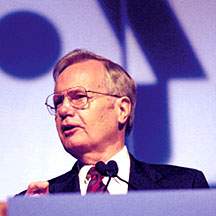|
PBS turns to Moyers Originally published in Current,
Dec. 18, 2001 Bill Moyers agreed to create and launch a new weekly current affairs series for PBS after the network couldn't get producing stations to agree on a major collaboration covering the aftermath of Sept. 11. John Siceloff left his senior production job at ABC's Sept. 11 response series, America.01, to head the new Friday night series Now with Bill Moyers, which goes on the air Jan. 18 [2002]. "We don't know yet what this broadcast is going to be," said Moyers, host and managing editor of the series. The first broadcast "is a total blank in our minds right now." Contributions from NPR and final funding agreements with CPB and PBS are still under discussion. PBS, meanwhile, has given a second chance to another new public affairs series, Life 360, and apparently shelved a third, Public Square. The network will replace three January installments of Life 360 with the new Moyers series and give the show's producers at ABC's Nightline unit a chance to refine it for a new timeslot this summer. PBS launched Life 360 with a major promotion push in October. The show attracted critical acclaim but too few viewers. John Wilson, PBS co-chief program exec, announced the programming changes to stations early this month, but in an interview declined to describe the new Moyers series. He earlier told stations the series will combine documentary elements, essays and commentaries with conversational segments similar to those Moyers delivered during PBS's September crisis coverage. Moyers' popularity with PBS viewers and stations, his journalistic sensibility and the foundation grants that he can bring into the funding mix made him a clear candidate for the assignment. During his more than 25 years in broadcasting, he has become PBS's most recognized public affairs interviewer, capable of delivering both hard-hitting journalism and essays that tackle life's big questions. PBS had wanted to create a consortium of producing stations and NPR to assemble a blockbuster next-generation series. It's unclear whether PBS can bring together its strongest production assets, as the network pledged to do with Public Square. A proposal to bring that series to air next season stalled after it came in with a $20 million budget, according to several sources. Its assigned creator, Michael Sullivan, has returned to producing for Frontline. After the September terrorist attacks, PBS initiated talks about creating a responsive new weekly public affairs series. The aim was to satisfy the public's appetite for crisis coverage with a show that could establish itself as a distinctive, relevant and ongoing alternative to network and cable news programs. PBS and CPB pooled just under $10 million to invest in a series that PBS execs said could "evolve" into something like Public Square. "We wanted to have a show that would provide a vehicle for covering events post-Sept. 11 and the complex stories that came out of that, as well as a vehicle connected to elements of the Public Square show," said Andy Russell, CPB senior v.p. of media. "We were trying to keep both of those aims in mind." NPR involvement and collaborations among producing stations were "very positive goals" but not absolute mandates from CPB, Russell said. PBS and CPB also wanted to back a show that could eventually sustain itself with other funding. CPB's criteria broadly describe the desired series as a "reliable venue where viewers can turn to hear the issues of the day addressed in a balanced and informative way, placed in context, and presented by a variety of voices from a variety of perspectives," according to spokeswoman Jeannie Bunton. Topics would be political, social and cultural. The right skill setsIn its earliest bid to develop a timely, ongoing response program, PBS turned to producers of Life 360 and asked them to reconfigure their plans and focus on the attacks and their aftermath. PBS was either rebuffed or changed its mind about this plan, according to sources with differing accounts. "We realized this was not the way to approach this series," said Wilson. "We were asking the show to do something it was not created to be." "The idea was attractive to me, and it was logical that they asked," said John Lindsay, production chief for Life 360 co-producer Oregon Public Broadcasting. "At the end of the day, we couldn't have delivered the right skill sets," largely because the series was set up to be artful and creative instead of news-driven. Other proposals discussed at Braddock Place included a collaboration between WETA in Washington and National Public Radio, and a WGBH concept involving the New York Times. Participants in these talks couldn't agree on editorial control issues, and PBS's own ambitions to shape the program made station execs uncomfortable. "PBS didn't seem to understand that the important decision for them to make was choosing an executive producer or managing editor in whom they could place their full trust for the responsibilities of doing it," said a source familiar with the talks. When Moyers later agreed to take on the roles of host and managing editor, "it became clear that what would make the most sense was to have [Moyers production company] Public Affairs Television at the center of the production," said Wilson. Rather than creating the series "out of a network of stations and trying to find its center, it makes the most sense to have the production center clearly identified." "The need to have someone in charge of this show and make the ultimate calls" came up in the consortium talks, said Russell. Having a consortium with "multiple heads" working under different agreements created too many tensions. Moyers' company was the one choice among major PBS producers that the public TV system could get behind, according to Russell. The outcome disappointed at least one public TV executive not involved in the talks. "In our business, organizations are so parochial and looking after their own interests, instead of thinking about what would be nice for public television as an institution, and even what would be nice for the audience," he said. "We ended up with a Moyers show that's going to be fine. But it's too bad that we can't put together the different assets that people have into a single program." That would not have been easy to pull off, the executive acknowledged. "Collaboration is always difficult. It takes real leadership at the national level. A lot of our friends at PBS aren't sophisticated enough to do that." Not having a centralized production center, like NPR's, "handicaps us enormously," the executive said, though he sees no hope of that changing. When PBS and NPR were created more than three decades ago, PBS was forbidden to produce programs in deference to two forces. Several producing stations were already in existence, and they opposed production authority for PBS. The Nixon administration also was against a centralized production unit. "But they didn't pay attention to radio," the executive explained. Educational radio was such a small matter that it needed a production center and was allowed to have one, at NPR. "I'm delighted to hear that Moyers is coming back," said another onlooker, Jim Pagliarini, president of Twin Cities PTV. Though he said he loved the idea and some segments of Life 360 and was disappointed to hear that Public Square has been shelved, Pagliarini doubts PBS should put much effort into developing new public affairs series. The network already has enough public affairs on its schedule, and so do many other outlets, he said. "It would be difficult to break through the kind of clutter that exists in news and public affairs." To his mind, it would be better if PBS invested in its strong suits--history, science and children's programming. This summer the Twin Cities station canceled NewsNight Minnesota for similar reasons. Pagliarini sees no need to try to duplicate on TV what NPR does on radio. "It has to do with the different cost structure of radio. . . . For television to undertake anything that ambitious would require financial resources that just don't exist in our system." Life with no cabaretLife 360's first season will end a few weeks early to make room for Now with Bill Moyers on Friday nights at 9. It will reappear this summer with five or six new episodes--the three that were pulled from January and four repackaged repeats. Midway through the first season the producers dropped the cabaret setting in which host Michel Martin delivered segues and introduced musical performances. "In the new shows, the material with Michel will be very location-centric," said Lindsay. Producers are looking for ways to better integrate musical performances into the theme of each show. Viewers liked the music "but needed more help with connecting it to the themes," said Janet Tobias, executive producer. Producers will be "reaching out into the system to find new talent and good ideas, now that we have established more of a template." "We made bets about what would work and what wouldn't," said Lindsay. The cabaret was a "very expensive" set-up. With hindsight, he would have put more money into animated pieces, like "Caesar's Last Breath" by Robert Krulwich. "What makes it different, and what could make it succeed, are the pieces by Ron Suskind and Krulwich, the creative animation and music that really ties well to the theme." "We absolutely agree with PBS that this was the right show at the wrong time," Lindsay said. "We got great reviews, but nobody was watching." The W's-- Washington Week in Review and Wall Street Week--were the wrong lead in for <I>Life 360<I> because they attract an older demographic than the new series aimed for. The post-Sept. 11 climate also made its launch difficult. "The show is good but it's hard to find an audience considering everything that's been going on on television," said Garry Denny, program director at Wisconsin PTV. He said he was a naysayer before the show debuted but was won over by the first couple of episodes. Producers and programmers alike were disappointed with Life 360's ratings, which ranged from 0.7 in the Nielsen overnights to a high of 1.1, according to Lindsay and Tobias. A lot of stations scheduled Life 360 an hour later than the 9 p.m. PBS feed, noted Lindsay. "A 1.1 at 10 is better than a 1.1 at 9, but it's still below what we want." Wilson cut off an interview when asked about Life 360's ratings performance. PBS pledged in its strategic plan to boost its primetime audience over the next three years by adding new programs, revamping its schedule, redefining its target audience and buying aggressive promotion campaigns. Its goal for next year is to boost its primetime average from 2.0 to 2.1. |
The production company has two months to launch Now with Bill Moyers. |



